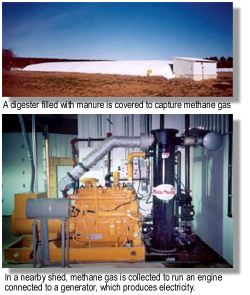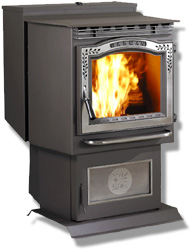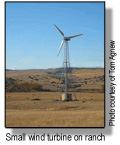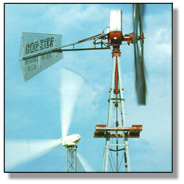As of March 31, 2004: 21,658 loans for $168.1 million Questions and Answers... 5% Dollar and Energy Saving Loans
The Nebraska Energy Quarterly
features questions asked about 5% Dollar and Energy Saving Loans.
Loan forms may be obtained from participating lenders, the Nebraska Energy
Office, or the agency's web site by clicking on the “Loan Forms”
button above.
 To determine if the project can be financed with a loan, a number of factors must be evaluated:
To determine if the project can be financed with a loan, a number of factors must be evaluated:
- What was the electricity cost to irrigate last year?
- Multiply that number by 10 years.
- If the amount you would save is greater than the amount it will cost you to install the digester, then the project might qualify for a loan.
 In determining if the stove can be financed, look at what is currently spent for heating. Examine the utility bills for a full year. If natural gas is used, look at the gas bills for the summer months. During summer there will be little or no heating costs, only costs for appliances such as hot water, clothes drying or cooking. Subtract that amount from the winter gas bills to determine the amount currently spent for heating. If you have an air source heat pump, or other type of electric heat with air conditioning, look at the lowest electric bill in the spring and fall, which would represent the electricity you use for water heating, stove, lights, television, computer and other uses. If propane is used, and it is delivered so that you cannot determine how much is used for cooking and hot water, a good estimate is one-third for cooking and hot water, and two-thirds for heating. Also calculate the therms, kilowatt hours, or gallons of fuel you use.
Next, examine the efficiency of the current heating equipment and calculate the amount of heat needed for the home. If you have a 90% AFUE (Annual Fuel Utilization Efficiency) gas furnace, and know 50 million British thermal units (Btus) of energy were used for heating purposes (from the previous calculation), then 45 million Btus will be needed to heat the home, or 50 million times 90% (0.90) equals 45 million.
If an air source heat pump with a HSPF (Heating Seasonal Performance Factor) of 7.8 provides heating and 5,770 kilowatt hours of electricity were used, then 45 million Btus were used to heat the home, or 5,770 kilowatt hours times 1,000 watts per kilowatt times 7.8 HSPF equals 45 million Btus.
In determining if the stove can be financed, look at what is currently spent for heating. Examine the utility bills for a full year. If natural gas is used, look at the gas bills for the summer months. During summer there will be little or no heating costs, only costs for appliances such as hot water, clothes drying or cooking. Subtract that amount from the winter gas bills to determine the amount currently spent for heating. If you have an air source heat pump, or other type of electric heat with air conditioning, look at the lowest electric bill in the spring and fall, which would represent the electricity you use for water heating, stove, lights, television, computer and other uses. If propane is used, and it is delivered so that you cannot determine how much is used for cooking and hot water, a good estimate is one-third for cooking and hot water, and two-thirds for heating. Also calculate the therms, kilowatt hours, or gallons of fuel you use.
Next, examine the efficiency of the current heating equipment and calculate the amount of heat needed for the home. If you have a 90% AFUE (Annual Fuel Utilization Efficiency) gas furnace, and know 50 million British thermal units (Btus) of energy were used for heating purposes (from the previous calculation), then 45 million Btus will be needed to heat the home, or 50 million times 90% (0.90) equals 45 million.
If an air source heat pump with a HSPF (Heating Seasonal Performance Factor) of 7.8 provides heating and 5,770 kilowatt hours of electricity were used, then 45 million Btus were used to heat the home, or 5,770 kilowatt hours times 1,000 watts per kilowatt times 7.8 HSPF equals 45 million Btus.
 Now, calculate how much corn will be needed for heating. Find out the efficiency of the corn burning stove. Divide 45 million Btus needed to heat your home by the efficiency rating for the stove. For example, if the stove is similar to a conventional furnace and will be connected to a ducted forced air system, and has an efficiency of 77%, then 45 million Btus divided by 77% (0.77) equals 58.5 million Btus of corn. If the stove is a free-standing sealed unit using outside combustion air and has an efficiency of 50%, then 90 million Btus of corn would be needed, or 45 million Btus divided by 50% (0.50) equals 90 million Btus. If the stove is free-standing and uses the home’s conditioned air with natural draft similar to a fireplace, the stove might have an efficiency of 33%. In this case, 136 million Btus of corn would be needed.
Now, calculate how much corn will be needed for heating. Find out the efficiency of the corn burning stove. Divide 45 million Btus needed to heat your home by the efficiency rating for the stove. For example, if the stove is similar to a conventional furnace and will be connected to a ducted forced air system, and has an efficiency of 77%, then 45 million Btus divided by 77% (0.77) equals 58.5 million Btus of corn. If the stove is a free-standing sealed unit using outside combustion air and has an efficiency of 50%, then 90 million Btus of corn would be needed, or 45 million Btus divided by 50% (0.50) equals 90 million Btus. If the stove is free-standing and uses the home’s conditioned air with natural draft similar to a fireplace, the stove might have an efficiency of 33%. In this case, 136 million Btus of corn would be needed.
 If you call the local elevator and request 52 million Btus of corn, they will send someone out to measure you for a new white suit! The Btus need to be converted to bushels. Corn, when converted to dry matter will have a Btu content of 8,000 to 8,500 Btus per pound. Unfortunately, corn with zero percent moisture is hard to find! Corn at 15.5% moisture, typical for stored corn, has a Btu content of between 6,800 Btus a pound, or 381,000 Btus a bushel.
If you call the local elevator and request 52 million Btus of corn, they will send someone out to measure you for a new white suit! The Btus need to be converted to bushels. Corn, when converted to dry matter will have a Btu content of 8,000 to 8,500 Btus per pound. Unfortunately, corn with zero percent moisture is hard to find! Corn at 15.5% moisture, typical for stored corn, has a Btu content of between 6,800 Btus a pound, or 381,000 Btus a bushel.
 The Btu content drops as moisture increases. If 52 million Btus of corn is needed, that equals 136 bushels of corn. Corn at a price of $2.22 (as of August 29, 2004) a bushel equals $302.
If the corn stove costs $3,000 and a 15 year simple payback is needed, the calculation would be: $3,000 divided by 15 years equals $200. So, $200 a year would need to be saved. If $302 worth of corn is used, then the bill for heating must be $502 or higher. That calculation is: $502 for the current heating bill, minus $302 worth of corn, which results in a $200 a year savings.
The Btu content drops as moisture increases. If 52 million Btus of corn is needed, that equals 136 bushels of corn. Corn at a price of $2.22 (as of August 29, 2004) a bushel equals $302.
If the corn stove costs $3,000 and a 15 year simple payback is needed, the calculation would be: $3,000 divided by 15 years equals $200. So, $200 a year would need to be saved. If $302 worth of corn is used, then the bill for heating must be $502 or higher. That calculation is: $502 for the current heating bill, minus $302 worth of corn, which results in a $200 a year savings.
 The calculations are nearly done. At the beginning, it was calculate that 50 million Btus of natural gas or 5770 kilowatt hours of electricity were need to heat the home. Divide $502 (the current heating bill) by those amounts of energy. The results are prices of $1.00 per therm of natural gas, or 8.7 cents a kilowatthour. So, energy costs would need to be $1.00 or more per therm for gas, or 8.7 cents per kilowatt hour or more for a a corn burning stove to be financed with a loan, provided the stove that is similar to a typical gas furnace with ducted forced air system.
This answer was provided as guide for using Forms 32 & 33 for the potential purchase of a corn burning stove, and should not be used to determine what source of heat is best for any one individual. Individuals should always weigh alternatives when making a purchase. For heating and air conditioning, it is important to consider proper sizing, efficiencies, initial costs, energy costs, service and reliability. Other factors such as convenience and comfort are also important. The method of calculation could be used for calculating savings when burning other fuels.
Notes and Resources
An existing heating system could be kept as backup, if it is already listed as a prequalified system such as a gas furnace with an AFUE of 90% or higher, an air source heat pump with an HSPF of 7.8 or higher, a geothermal heat pump with a COP of 3.0 or higher, a steam or hot water boilers with an AFUE of 83% or higher, gas radiant heat with a combustion efficiency of 80% or higher, a unitary room heat pump with a COP of 3.0 or higher, and combined water and space heating with a CAE of 74 or higher.
The Btu content of corn was based on areport from Penn State University.
The 77% AFUE for a corn burning stove was based on areport from the Ontario Ministry of Agriculture which found efficiencies for corn burning furnaces ranging from 70 to 85%. The Ministry’s efficiencies may not have been AFUE, which takes into account fan usage, typically a small amount, which might reduce the efficiency by 1 to 2 percentage points.
The calculations are nearly done. At the beginning, it was calculate that 50 million Btus of natural gas or 5770 kilowatt hours of electricity were need to heat the home. Divide $502 (the current heating bill) by those amounts of energy. The results are prices of $1.00 per therm of natural gas, or 8.7 cents a kilowatthour. So, energy costs would need to be $1.00 or more per therm for gas, or 8.7 cents per kilowatt hour or more for a a corn burning stove to be financed with a loan, provided the stove that is similar to a typical gas furnace with ducted forced air system.
This answer was provided as guide for using Forms 32 & 33 for the potential purchase of a corn burning stove, and should not be used to determine what source of heat is best for any one individual. Individuals should always weigh alternatives when making a purchase. For heating and air conditioning, it is important to consider proper sizing, efficiencies, initial costs, energy costs, service and reliability. Other factors such as convenience and comfort are also important. The method of calculation could be used for calculating savings when burning other fuels.
Notes and Resources
An existing heating system could be kept as backup, if it is already listed as a prequalified system such as a gas furnace with an AFUE of 90% or higher, an air source heat pump with an HSPF of 7.8 or higher, a geothermal heat pump with a COP of 3.0 or higher, a steam or hot water boilers with an AFUE of 83% or higher, gas radiant heat with a combustion efficiency of 80% or higher, a unitary room heat pump with a COP of 3.0 or higher, and combined water and space heating with a CAE of 74 or higher.
The Btu content of corn was based on areport from Penn State University.
The 77% AFUE for a corn burning stove was based on areport from the Ontario Ministry of Agriculture which found efficiencies for corn burning furnaces ranging from 70 to 85%. The Ministry’s efficiencies may not have been AFUE, which takes into account fan usage, typically a small amount, which might reduce the efficiency by 1 to 2 percentage points.
 To be financed, the project would need to show a simple payback of 10 years or less. While we live in a public power state that has some of the lowest electric rates in the country, this does not lend itself to substantial savings when comparing the cost of a wind system to low electric rates.
When evaluating wind energy systems, realize that the wind doesn't blow all the time, and when the wind does blow, it may not blow at the maximum rating of the turbine. These two facts, plus estimation of expected energy consumption and the size of turbine needed, are factors when determining whether or not a battery backup will be needed.
The fact that the wind doesn't blow all the time is one reason to consider a battery backup. When the wind does blow, the turbine can charge the battery and also provide electricity to the home. Then when the wind isn't blowing, the battery can supply electricity to the home. Of course, a battery backup adds to the cost of the total system.
To be financed, the project would need to show a simple payback of 10 years or less. While we live in a public power state that has some of the lowest electric rates in the country, this does not lend itself to substantial savings when comparing the cost of a wind system to low electric rates.
When evaluating wind energy systems, realize that the wind doesn't blow all the time, and when the wind does blow, it may not blow at the maximum rating of the turbine. These two facts, plus estimation of expected energy consumption and the size of turbine needed, are factors when determining whether or not a battery backup will be needed.
The fact that the wind doesn't blow all the time is one reason to consider a battery backup. When the wind does blow, the turbine can charge the battery and also provide electricity to the home. Then when the wind isn't blowing, the battery can supply electricity to the home. Of course, a battery backup adds to the cost of the total system.
 Since the wind may not blow at the maximum rating of the turbine, a larger sized turbine may be needed.
For example, if the amount of energy needed is 15 kilowatthours and the average wind speed for the area is 15 mph, then select a turbine that not only generates 15 kilowatts, but one that generates 15 kilowatts in a 15 mph wind.
All of these factors should be considered when evaluating the purchase of a wind turbine. Periodic maintenance for a wind turbine or battery backup system should also be included.
When completing a wind turbine project evaluation using information from a company, be sure that it includes maintenance costs, maintenance materials and and interest, which can then be compared the amount for electricity would otherwise be paid to a utility.A less important, non-economic factor may also include having your own source of energy which can provide a sense of security to some individuals.
Since the wind may not blow at the maximum rating of the turbine, a larger sized turbine may be needed.
For example, if the amount of energy needed is 15 kilowatthours and the average wind speed for the area is 15 mph, then select a turbine that not only generates 15 kilowatts, but one that generates 15 kilowatts in a 15 mph wind.
All of these factors should be considered when evaluating the purchase of a wind turbine. Periodic maintenance for a wind turbine or battery backup system should also be included.
When completing a wind turbine project evaluation using information from a company, be sure that it includes maintenance costs, maintenance materials and and interest, which can then be compared the amount for electricity would otherwise be paid to a utility.A less important, non-economic factor may also include having your own source of energy which can provide a sense of security to some individuals.
">Home
sept2004/Energy
Loans sept2004/
Energy Statistics
mailto:energy1%40mail%2estate%2ene%2eus">![]() State
of Nebraska Home sept2004/disclaimer.htm">
Disclaimer
sept2004/feedback2.htm">Webmaster
State
of Nebraska Home sept2004/disclaimer.htm">
Disclaimer
sept2004/feedback2.htm">Webmaster